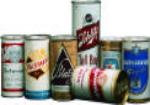

| Growlers and Cans By Jim Attacap Growlers and Cans .... Oh My! Today nearly every brewpub is happy to sell you a growler, a half-gallon glass container filled with their ales and lagers. Essentially a growler is a glorified bucket, an upscale pail. In fact, long before beer was dispensed in cans there were growlers. Over one hundred years ago a growler looked like a galvanized pail with a lid on it. People hauled it from the pub to home to enjoy fresh beer at their leisure or at work (yes, on the job beer drinking preceded the two martini lunch.) History however is a bit unclear on just how this container became known as a growler. Perhaps it growled when the carbon dioxide escaped; maybe it was the rumble from the workman's hungry stomach at lunch just before the container was opened. Whatever it was, the name stuck. Before World War II, kids used to lug these covered buckets of beer to workers at lunch and to their parents at the end of the day. They called their task "rushing the growler". The galvanized metal growler gave way to waxed cardboard containers by the 1950's. The cardboard did eventually soak through but anyone who waited that long to drink their beer probably wouldn't have bought it in the first place. Just as the cardboard container sales began to soar many states began allowing liquor sales on Sundays prompting people to simply go to the bar for a fresh pint than drink from a container at home. Fresh draft beer beat container stored draft beer every time. Then in the late 1980's a small brewpub in Wilson, Wyoming* run by the Otto brothers decided to put their beer in glass vessels that looked a lot like moonshine jugs. They put their logo on the bottle and the rest was soon to be beer history. A new, filled growler (the bottle is yours to keep) generally costs between $10 to $15; refills between $7 to $10. For most beer fans a full growler empties quickly, just as it should. If the lid is tight and the growler kept cool, the beer could last for nearly a week. If however you need a longer shelf life consider beer in cans. The origins of the beer can can be traced back to 1909 when a brewery in Pennsylvania approached the American Can Company to see if it could supply cans for the packaging of beer. It could not. The early cans often crumbled under the high pressure of carbonated beverage and there was always a bad reaction between the beer and metal. The development of a usable beer can was put on hold as Prohibition began in 1919. However in 1931, with the end of Prohibition in sight, the American Can Co. again began to experiment with canned beer. They were able to produce a can that could withstand pressure of over 80 lb per square inch without bursting along the welded seam. They then created a special coating for the inside of the can to stop the beer from reacting with the tinplate. Now their only problem was to convince the reluctant big breweries that this innovative device would indeed work and not ruin sales forever. One smaller brewer was especially intrigued. It was the Krueger Brewery of Newark, NJ. After all the years of Prohibition and the death in 1926 of Gottfried Krueger, the brewery's founder, the family business was not in good shape. The Krueger heirs thought that cans might be the only hope to save their company since even good beer sometimes needs a gimmick to sell. To seal the deal, American Can agreed to install all necessary equipment for free and the brewery would only pay for it if the venture was a success. Krueger quickly agreed. A test run of 2,000 cans was produced in 1933 and these were sampled by regular Krueger drinkers (most likely sem-sober at the time) who overwhelmingly (91%) said they liked the canned beer. It took until January 1935 however for the first beer cans to go on sale to the general public. Still hedging their bet, the company selected Richmond Virginia, far away from their home base, for the first sale of their Krueger's Finest Beer in cans. It was an instant hit. The Krueger brewery was revived overnight and as for the American Can Company, within a year they became the primary supplier of no less than 37 breweries who rushed to produce canned beer. |



| G. Krueger Brewing Co. American Can Company June 24, 1933 Newark, NJ |
*Thanks to Patti Marshall for growler information.
beernexus.com - SPECIAL REPORT
The History of Growlers and Beer Cans
-

